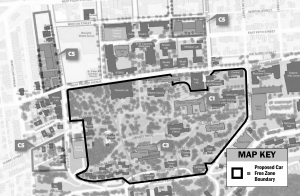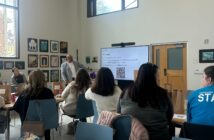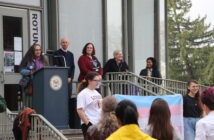
Courtesy of Lehigh University
A car-free zone has been proposed in Lehigh’s Campus Master Plan to decrease driving on campus and to limit vehicular access and parking within the core campus. Although none of the plans have been approved, the possibilities are being discussed.
Over the years, the landscape of the campus has been damaged by over-development of roads, parking and services in the middle of the campus, according to the Master Plan. The hope is creating an expanded car-free zone on the Asa Packer campus will return the land to pedestrians and remove barriers between residential and academic areas.
The ultimate goal is to have fewer cars driving through campus and instead have students, faculty and staff primarily use the buses. The university would like to increase the walkability on the Asa Packer campus and between the other two campuses, Mountaintop and Murray H. Goodman.
This plan is meant to build on the success of Memorial Walkway and Library Drive, both of which allow pedestrians to safely walk. With the construction completed on Williams Hall this past year, the walkability surrounding the building has improved with a new walkway and redirection of the cars into a different lot.
“Those are the kinds of things we’re looking to do in the interior roadways that are remaining,” said Mark Ironside, the executive director of business services.
Ironside said the car-free zone can be implemented over time as the campus evolves, and Lehigh has been planning for a 3-5 year time span.
“Obviously, there are a number of reasons less cars is positive,” Ironside wrote in an email. “Less cars mean less traffic around campus, less of a demand for parking lots and the related maintenance costs, improved safety, more walkability and, of course, sustainability is a big driver.”
The Master Plan also proposes a more seamless, continuous path system to connect all students on the Hill to the academic core campus. As of now, as one moves up the hill to the portion of campus that surrounds Coppee, Drown and Johnson Halls, pathways are bisected by roadways and often there are not safe pedestrian crosswalks.
The continuous path system will help fix this broken network and will help make the walking route from Asa Packer Campus to Mountaintop Campus continuous and safer.
The paths within the car-free zone will still allow service and emergency vehicles to quickly drive up campus, but it will be more pedestrian friendly with a narrowed width of the roads and less parked cars, according to the Master Plan.
The plan also addresses the problems for pedestrians on portions of Upper and Lower Sayre roads. These areas are hazardous for vehicles with their sharp turns, especially in inclement weather, and have few walking paths for pedestrians. This has led to an initiative to transform these roads into a one-way loop for a safe area for all modes of transportation, including vehicular, biking and walking.
Additionally, a new bus route called the Packer Express will run throughout the main campus with two additional stops on the Hill.
“This new route is designed to be more frequent which will help to get our students, faculty and staff around quicker,” Bob Bruneio, the manager of transportation services, wrote in an email. “We are implementing expanded bus services, more frequent bus routes and making sure we implement the Packer Express in the fall.”
By further developing the pedestrian path system, Lehigh is attempting to focus the attention on the pedestrian experience.
As the university looks at construction projects, they look at the site to see how parking or pedestrian walking can be enhanced or improved by those projects. Each construction site is not just looked at as a building project, but as a way to help pedestrian flow.
“They are trying to improve the Lehigh campus as a whole, which is great,” said Matt Rothberg, ’18, the Student Senate assistant treasurer, who met with Parking Services about the plan. “There are a lot of great ideas, but I’m sure some of it will end up being controversial because it is such a huge plan and it’s making a lot of changes, which is why it is important that the Lehigh community knows about it and it is very public so they can get students opinions.”
Parking fees and institutional resources are used to fund aspects of the transportation system.
“Just like any other Master Plan, it’s conceptual, so as you think about implementation you have to look at the overall financial model and make choices about what the priorities are,” Ironside said. “The university will have to make some choices at what level of funding it would want to provide.





Comment policy
Comments posted to The Brown and White website are reviewed by a moderator before being approved. Incendiary speech or harassing language, including comments targeted at individuals, may be deemed unacceptable and not published. Spam and other soliciting will also be declined.
The Brown and White also reserves the right to not publish entirely anonymous comments.